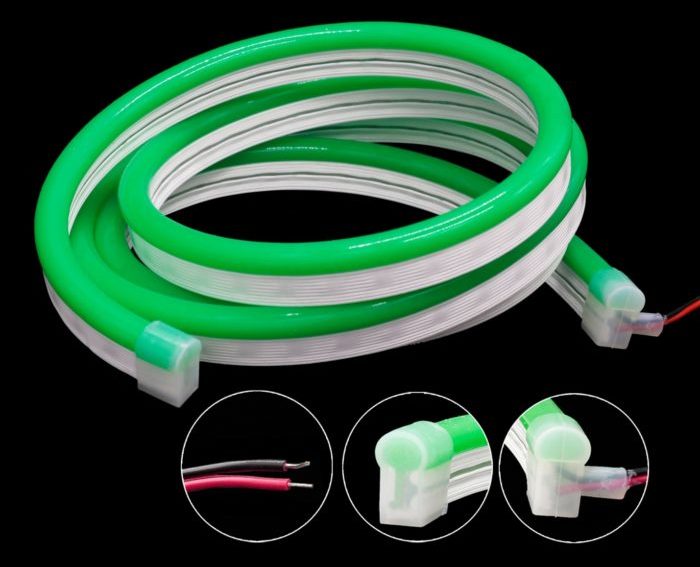How to make a neon sign with your own hands
A relatively new appearance on the market flexible neon has spread very quickly in many areas and has become a handy advertising tool. With its help, you can create almost any pictures and inscriptions that attract customers. Such a design can be ordered ready-made or you can make it yourself.
What is the flexible neon
The features of flexible neon are the uniformity of illumination, stability and resistance to external factors.

It includes:
- A set of LEDs that converts electricity into a bright glow.
- Wiring. A set of wires switching diodes with each other.
- Sheathing. A flexible structure made of silicone or polymeric materials. Can be virtually any color. Performs a protective function, as well as forming the necessary shade of glow.
Where you can use a flexible neon
The most common areas include:
- Decorating the facades of buildings, architectural monuments;
- Registration of advertising signs, banners and billboards;
- Park decoration with illumination of trees and bushes;
- car design (body, interior);
- interior design of clubs, bars and other establishments.

Making neon signs with their own hands
You can make a neon sign with your own hands. This will require some tools, materials and basic skills of working with electrical circuits. It is important to comply with safety regulations.
A video will tell about the manufacture of neon signs with their own hands
Preparation of tools and materials
For self-made will be required:
- flexible neon (models for 12 or 24 V will do);
- power supply;
- fixtures (profile, staples, etc.);
- plugs for loose wire edges;
- glue;
- aluminum flat tube for the frame;
- soldering iron;
- paper or cardboard to create the necessary layout;
- insulating tape;
- a special 2-pin connector to connect the neon;
- sandpaper;
- knife or scissors.
Other tools may be required: vise, gaskets or sealants. The specific set will depend on the type of mounting chosen and the specific features of the design.
Creating a signboard

Order of work:
- On paper or cardboard, draw a layout of the future structure.
- Form a frame from a flat tube, and then weld in the right places.
- Weld fasteners to the wall to one side of the frame.
- Sand and polish the resulting structure with emery cloth.
- Mount the profile or other selected fixings for the wire along the entire length of the loop at a short distance. For durability, set it on the glue.
- Coat the resulting frame with primer and wait for it to dry.
- The flexible neon is mounted in appropriate fixtures. Glue can be used to reinforce it.
- Parts of the tubes are soldered together, and then all connections are insulated.
- Cut off the excess part of the tubes.
- Connect to the mains via the power connector.
- Check that the system is working properly.
- Use insulating tape and plugs to ensure that the circuit is completely sealed.
In this way you can create signs in the form of pictures, words or entire phrases. It remains to install the design in the right place and conduct the power.
How to solder flexible neon properly
Connecting the tubes is done with a soldering iron, preferably up to 40W. Heat shrink tubing and electrical tape are used for insulation.

Order of soldering neon:
- Carefully remove the insulation (silicone or polymer) from the tube about 1 cm from the edge. To do this, heat it with a lighter and then gently pull it off.
- Clean the contacts of carbon deposits and insulation residues.
- Use a knife or other sharp instrument to scrape off the phosphor layer.
- Connect the two outer braid wires in a pigtail.
- Remove the insulation from the power cable. It is important to carefully wipe the contacts with a special gel, and then apply solder to them.
- Three heat-shrinkable tubes (one large diameter and two small) are put on the power cable.
- One of the cores of the power cable is connected to the cores on the outer sheath of the neon and soldered.
- The prepared thermal tube is shifted and shrunk under the influence of high temperatures, completely insulating the connection.
- In the same way the central core of the neon is connected to the second contact of the power cable.
- It remains to slide the wide tube into place and ensure the tightness of the connection.
How to hang
Neon signs can be attached in different ways, and it is from this that the appearance will depend. One of the most common options is the ceiling mount in the window or on the wall.

In this case, the image or inscription is attached to a substrate of plastic or plexiglass with wires or thick fishing line. To do this, holes are drilled in the substrate, and hooks or other fasteners are installed on the ceiling.
Often there are signs that are attached directly to the walls without any backing. In this case, the profiles or brackets for installing neon tubes are fixed to the wall without a frame. The installation process requires certain skills. Most of the problems arise at the wiring and power connection stage.
Very common are signs in the form of neon letters on a frame suspended from the ceiling. The frame is usually created from aluminum or some lightweight but durable alloy. The suspension is also created using hooks and sturdy ropes or fishing line.
Making a sign from flexible neon, without the use of professional equipment
How to extend the life of a neon sign
The finished neon sign is quite durable and resistant to various influences. To prolong the service life, it is recommended to adhere to the rules:
- For street signs, it is mandatory to use tubes with protection against moisture and dust.
- It is not a good idea to turn on the structure while the covers are on. This will impede heat dissipation and cause overheating.
- The voltage and current supplied to the electrical circuit must conform to the standards prescribed in the data sheet.
- It is advisable to regularly clean the structure from settled dust.
- Operating conditions (temperature, humidity) must be within the specified range.
The recommendations described above will keep the signage in serviceable condition for a long time. And since signs are usually created to last, increasing the life of the products proves to be fundamental.
